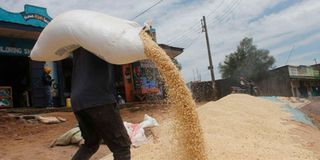Cereals board pricing mocks desperate maize farmers

A man spreads maize out to dry by the roadside in Elburgon town in Nakuru County on October 18.
The announcement on Wednesday that the National Cereals and Produce Board (NCPB) had started buying maize from farmers at Sh1,305 per 50kg bag was very underwhelming. But that is not the worst of it.
The most irksome bit was the predictability of the message. To farmers in the North Rift maize-growing areas, the NCPB is second only to the area politicians as their true villains.
Maize farmers, particularly the many that are farming for survival, have given up on getting succour from their leaders. The lack of ambition seen in policy formulation and target setting, the inconsistency apparent in the execution of that policy, the anaemic attempts to provide support either through subsidies or advice on how to sustainably farm have become enduring representations of what to expect from the county government since agriculture was devolved, and from the national government before devolution.
When the NCPB tells a farmer in Trans Nzoia that it will pay her Sh1,305 for a 50kg bag of maize, it conveys contempt in the extreme. The message being passed across is that the whole six to eight months’ production process – from farm preparation, ploughing, harrowing (where necessary), seeds, fertiliser, herbicides; the labour that goes into weeding, harvesting, storing, threshing, packing and transport costs to the NCPB stores – will be compensated at a gross rate of only Sh26 a kilogramme. That is how ridiculous it is.
Apart from the few large-scale maize farmers that generally can store their produce until prices adjust upwards when there are shortages, or who sell directly to millers when cheap supplies from Uganda and Tanzania are unavailable, most of farmers in Uasin Gishu, Nandi, Trans Nzoia and parts of Bungoma counties are small-scale farmers operating on modest plot sizes of one to five acres.
Because of years of poorly managed chemical use and of perpetually growing maize, yields have been dwindling and very few farmers are harvesting even 10 bags of 90kg from an acre of land. They depend on that for food and income to cater for their subsistence needs. As if poor harvests are not sufficient punishment, the farmers have to be paid way below the production costs.
Ludicrous situation
Just this past week, in a dark joke at the NCPB announcement, someone shared a back-of-the-envelope cost breakdown of maize production on one acre to demonstrate how ludicrous this whole situation is: ploughing (Sh3,000); fertilizer (Sh4,850x2=9700); seeds (Sh2,000), harrowing (Sh1,500); herbicides (Sh3,400); top dressing (Sh6,400); staking (Sh1,500); shelling (Sh1,250); sacks for packing (Sh1,500). The harvest is around 20 bags (of 90kg), which gives an income of Sh46,800, translating into a profit of Sh16,550 or Sh46 a day (after a year of waiting).
Even if the President’s 2020 directive that traders buy maize from farmers at Sh2,500 for a 90kg bag had been diligently implemented, it could hardly have made any difference.
The base level that farmers have repeatedly asked for is at least Sh3,000 a bag. This has never been consistently achieved, except on the few desperate times the NCPB wanted to shore up the strategic grain reserves limits.
The dilemma of the maize farmer is a combination of several factors. Lack of a consistent, deliberately favourable policy to protect the local farmers against competition from neighbouring countries, improve their yields and storage, and access markets. Such a policy would make high quality inputs available at competitive rates; support an efficient extension scheme to educate farmers on climate-smart agricultural practices and optimal use of fertilisers and other chemical boosters; access to finance or credit schemes like the Warehouse Receipt Systems; market access and competitive pricing for monopoly public buyers like the NCPB.
County governments have access to vast amounts of knowledge generated through partnerships with development partners. The AGRA-originated and well-tested Village Based Advisor (VBA) extension system that it uses to reach farmers with inputs and advice of all types has been proven to work well in Kiambu, Makueni and elsewhere. It is a simple innovation that can be easily replicated and scaled.
But even a cursory look at the Trans Nzoia County Integrated Development Plan 2018-2022 confirms that at least in this case, a sound vision lacked the bold ambition that could signal clarity in understanding of the challenge, the courage to take it on and the innovativeness to show that the county leadership could gather the resources and crowd in partners to transform the lives of the smallholder farmers. And the results are apathetic.
The writer is a former Editor-in-Chief of Nation Media Group and is now consulting. [email protected], @tmshindi





